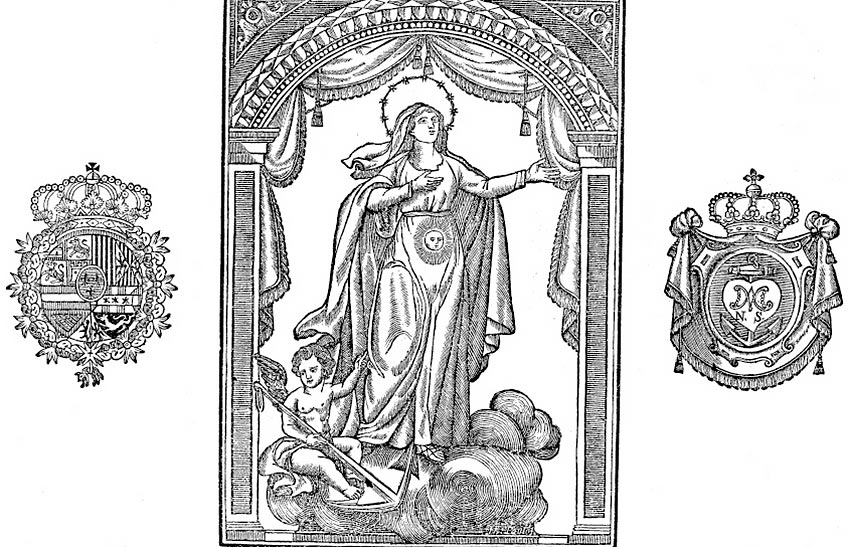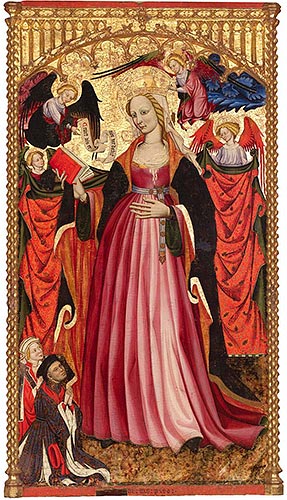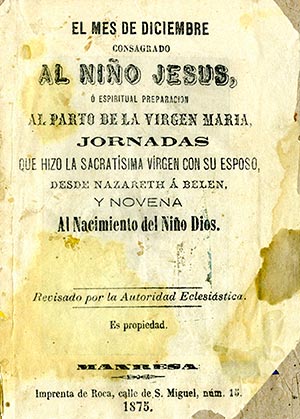Preparing for Christmas: a couple of celebrations from the December festive calendar

PhotoCedit/Xilographyof Our Lady of Hope, in a poster of her Congregation in Barcelona, 1828.
Until a few decades ago, the liturgical season of Christmas ended with the feast of Candlemas. The popular saying still reminds us: "Hasta la Purificación, Pascuas son" (Until the Purification, Easter is Easter). Until that day, there were some feasts such as the feast of the Sweet Name of Jesus, traditionally celebrated on the Sunday after the octave of Epiphany, until Rome fixed its feast on the second Sunday after Epiphany.
In the same way, Advent has been punctuated throughout the month of December with a number of celebrations that preach the imminent coming of the Messiah, although most of them have fallen into oblivion, at least with the contents and forms they had in the past.
The Virgin of Hope
The Virgen de la Esperanza or Virgen de la O is celebrated on the 18th of December and is a Marian invocation associated with the Advent or expectation of the Nativity of Christ, when the Virgin was pregnant. The reason for the name "O" is the admiring exclamation "O" that appears in the seven stanzas of the Vespers that precede Christmas, between the 17th and 23rd. Each antiphon is one of the names of Christ, one of his attributes mentioned in the Scriptures. On the 17th: O Sapientia (Wisdom), on the 18th: O Adonai (one of the names of God in Hebrew: my Lord), on the 19th: O Radix Jesse (Root of Jesse), on the 20th: O Clavis David (Key of David), on the 21st: O Oriens (Dawn), on the 22nd: O Rex Gentium (King of the Nations) and on the 23rd: O Emmanuel (God with us). The first letters of the titles, read in reverse, form the Latin acrostic "Ero Cras", meaning "Tomorrow, I will come", and reflect the topic of the antiphons.
In Pamplona Cathedral, music, i.e. voices and instruments, accompanied this official document. From the notes of the cathedral ceremonialist of the last third of the 19th century, we know that "at the first Vespers of the Expectation the antiphon O Sapientia is intoned by the Dean, for which the master of ceremonies accompanies him from his chair to the lectern, and after the whole antiphon has been sung, he accompanies him again to the stairs of the choir upstairs. On the following six days, the O's are sung by the most senior dignitaries or canons, at the invitation of the Dean or president of the choir, which he does through the master of ceremonies". In the convents, the nuns carried a kind of banner with the "O" decorated with different motifs and the letters of the beginning of the antiphon corresponding to each day.
The Virgin of Hope has some exquisite representations from the Gothic period. The stone sculpture in the basilica of the Virgen de la O in Pamplona, in the parish of San Lorenzo, in the district of Sandu Andía, from the convent of La Merced, is particularly noteworthy for its delicacy. The one that presides over the altarpiece in the Villaespesa chapel in Tudela cathedral, the work of Bonanat Zaortiga (1412), stands out for its delicacy.

Virgen de la Esperanza, titular of the altarpiece in the cathedral of Tudela, by Bonanat
Zaortiga, 1412
During the 16th century we have documentary evidence of some examples with typologies dependent on the apocalyptic Virgin, such as the sculpture that Domingo de Segura made for Obanos in 1554, with the sun in the Virgin's womb. In the Baroque period, a Marian temple was built in Valtierra under the patronage of the Virgen de la Esperanza, which has a rich Baroque altarpiece and an exceptional chapel with decorative Baroque paintings. Other chapels of the same name are to be found in Úgar and Ciriza. The only parish church of the Expectation of Our Lady is in Munárriz.
The conference
Among the traditional convent and family devotions were the Jornaditas, a kind of novena in preparation for Christmas. In Mexico they are still celebrated with great pomp, with a procession with luminaries starting from the church, with the images of Mary and Joseph and a donkey with an angel. Along the way, the unique pilgrims are asked for lodging again and again, until finally a door is opened. We know of several editions for the internship de las conference or Posaditas, and we know of the staging with images of St. Joseph and the Virgin in search of lodging.
At present, in Pamplona only the Discalced Carmelite nuns of Calle Salsipuedes continue to celebrate the conference, which begins on 16 December and ends on 24 December, with the reading of some considerations on the conference that Joseph and Mary made from Nazareth to Bethlehem.
The main staging is carried out by the daughters of Santa Teresa, at dusk on the 23rd, when the community, with lighted candles and singing, goes to one of the tribunes, where the delicate eighteenth-century sculptures of the pilgrims, that is to say Mary and Joseph, are located. The lyrics of the hymns read: "Saint Joseph who accompanies the Virgin / with loving sighs / says weeping: / Woe to my life / my sweet glory, / to my report, / adored garment, / Woe what I feel seeing you / so weary...". In the last stanza, the prioress takes the two images and sings other couplets from the conventual tradition, one of which says: "Shepherdess Virgin / Glory of Bethlehem / of a Prince Mother / who is also King / Come to our Valleys / of Lebanon come / You will be crowned, / Queen of Israel...". From this moment on, the ceremony gains momentum, as we go to the office of the Saint, and to the cells of the prioress and all the nuns, where each one prays, recites a poem or sings a carol to the visitors. At the end, in the choir, the corresponding exercise of the conference is carried out.
With this simple, symbolically charged story, it is not difficult to take us back to the cold, brick-lined corridors of the old convent at place del Castillo, for the tradition is still very strong. Then and now it was a matter of preparing the ways of Christmas, to delight the heart and feelings in the coming of the Saviour.

Cover of the conferencepublished in Manresa in 1875.
